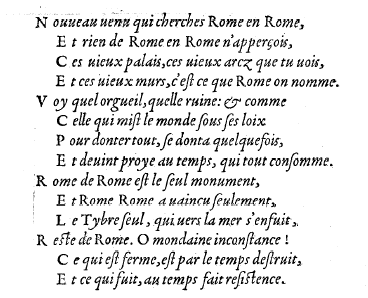webwork 5
INSTANCE CITY
de Riccardo ZANARDELLI (Italy), 2002
 "Instance City is presented as a Java Applet in a simple HTML web page. The aesthetic result of this work seems to [be] a city-profile, a perspective landscape that mixes buildings with a fictitious [vanishing] point. But behind the aesthetic result, the concept of this work, its heart, is the creation-process of every single shape (rectangle), provided by [a randomly generated algorithmic structure]. Instance City doesn't define fixed values for shapes in its source-code, but only ranges of values combined with random numbers generated [at run time] when the browser executes the byte-code. Thus, every city-profile is composed by a random number of rectangles, randomly sized and positioned (following a set of algorithmic rules) in order to create a meaningful result on the screen. In this case the generic class (defined in the algorithm) is [instantiated] every time with random numbers to produce an unique image on the screen."1
"Instance City is presented as a Java Applet in a simple HTML web page. The aesthetic result of this work seems to [be] a city-profile, a perspective landscape that mixes buildings with a fictitious [vanishing] point. But behind the aesthetic result, the concept of this work, its heart, is the creation-process of every single shape (rectangle), provided by [a randomly generated algorithmic structure]. Instance City doesn't define fixed values for shapes in its source-code, but only ranges of values combined with random numbers generated [at run time] when the browser executes the byte-code. Thus, every city-profile is composed by a random number of rectangles, randomly sized and positioned (following a set of algorithmic rules) in order to create a meaningful result on the screen. In this case the generic class (defined in the algorithm) is [instantiated] every time with random numbers to produce an unique image on the screen."1
Riccardo Zanardelli1
Each of these "cities," then, is simply a sketch - not even an ideal, vision, or dream, whether political, utopian or speculative: just a mathematical production, randomly generated, no sooner seen that it is gone. In black and white or in colour (in blue, green, and red),2 solid rectangles of various sizes cluster and spread, with variations in shading between them, producing a degree of spatial depth and suggesting some kind of urban agglomeration. From an architectural point of view, at least - but no openings, no streets, windows, or doors, and apparently lifeless, with no activity, no passersby, no event, no encounter. The work could have seemed oppressive, anxious, but its abstraction and, indeed, its beauty and visual elegance, avoid such an outcome. Its ephemeral appearance as well, due to its means of creation (on computer) and its support (the screen), the "virtual work" (in the Aristotelian sense of "a work of potentiality") - that is, the generic class defined by an algorithm - having as much, if not greater value than the "work in actuality" - e.i., the (randomly produced) series of instantiations of this class, the "city instances."
Yet, these fleeting visions of abstract, elusive cities, fading away as soon as they appear, can come to make up - in fast motion! - strange Relics, evocations of cities that might have been, or would or could be, will be perhaps, or perhaps never. In the end, these fragile rectangular shapes, assembled an instant in screen space, only rarely and precariously preserved by screen capture, produce an ultra-contemporary version of the well-known Classical and Renaissance topos (also found in more subjective form in Romanticism, as in Chateaubriand, among others): the vanity of life and human endeavour, as exemplified by the ruins of vanished cities, object of the philosopher's, poet's, or painter's meditation.
 3
3

Notes
1 : Synopsis written in English by the artist, cf. www.misterverynice.org/ 
2 : Black & White
Colour 
3 : "Thou stranger, which for Rome in Rome here seekest,
And nought of Rome in Rome perceiu'st at all,
These same olde walls, olde arches, which thou seest,
Olde Palaces, is that which Rome men call.
Behold what wreake, what ruine, and what wast,
And how that she, which with her mightie powre
Tam'd all the world, hath tam'd herselfe at last,
The pray of time, which all things doth deuouwre.
Rome now of Rome is th'onely funerall,
And onely Rome of Rome hath victorie ;
Ne ought saue Tyber hastning to his fall
Ramaines of all : O worlds inconstancie.
That which is firme doth flit and fall away,
And that is flitting, doth abide and stay"
Du Bellay, Joachim, Le premier livre des antiquitez de Rome. Num. BNF de l'éd. de [Paris] : [impr. de F. Morel], [1558]. in-4
Edmund Spenser's translation [1591] of du Bellay's Antiquités de Rome [1558], "Ruines of Rome : by Bellay," in The Poems of Spenser, edited by J. C. Smith, Oxford University Press, London, 1912 (reprint 1960).

Anne-Marie Boisvert
(Translated from French by Ron Ross)

 haut de page haut de page
 retour retour
|
